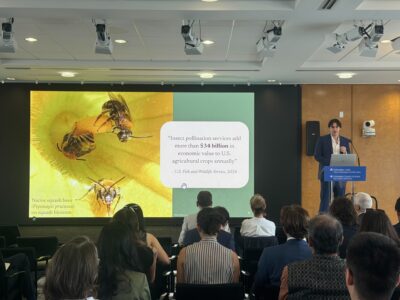
Before starting the MPA in Environmental Science and Policy program at Columbia University’s School of International and Public Affairs, Arnaud Goessens worked in a variety of capacities focusing on conservation and biodiversity. Arnaud moved to New York from his native Belgium to gain new policy-making skills and expand his professional network.
1. What drew you to the Master of Public Administration in Environmental Science and Policy program?
Recently, I made the decision to pursue a career in environmental policy. Prior to coming to this program, I had developed a strong background in environmental conservation as a bioengineer. Throughout my various positions in different organizations, I realized that in order to increase my personal impact towards protecting our environment, I would need to better understand environmental policies and work more closely with policymakers. After researching various programs, I found that the MPA-ESP program at Columbia was a great choice, as I would not only gain more in-depth knowledge on the policy-making process, but I could relate my prior experiences in a synergistic way. Lastly, the program is unique in that it is the only one-year program focusing specifically on environmental policy, and it takes place in the heart of New York City with unlimited opportunities to expand my career network.
2. What were you doing before you started the program?
I worked as a policy officer at the Wildlife Conservation Society—a world-leading environmental NGO. Based at the WCS Brussels Office, I supported the WCS International Policy program by advocating WCS positions to the European Union’s Institutions and developed working relationships with policy makers. Prior to my experience at WCS, I worked as a trainee at the European Commission, where I evaluated environmental projects to be funded under EU’s financial instruments.
Prior to my work at the European Commission, I worked as a consultant at the United Nations Development Programme in New York City. Specifically, I worked for the Global Environment Facility-Small Grants Programme and wrote case studies related to biodiversity, international waters, climate change and forest management.
Finally, in 2011 and 2012, I spent several months in Malaysia and Costa Rica, where I participated in the conservation of sea turtles and the protection of various wild animals including howler monkeys, sloths and the endangered great green macaws.
All these experiences allowed me to develop valuable skills and an understanding of conservation efforts around the world.
3. What area of environmental policy and management are you most interested in?
I am most interested in policies related to biodiversity conservation. I think that designing new management methods and increasing local communities’ involvement are fundamental aspects to protect and conserve our biodiversity. However, this involves complex issues with many known and unknown parameters—including the impacts of climate change—which need to be analyzed and integrated into conservation and management efforts.
4. What skills and tools do you hope to acquire through the program?
As I already have a strong background in the sciences, I hope to increase my understanding of the formulation and management of public policy. Through our various group projects and presentations, I also hope to improve my team management and communication skills that would allow me to become a more effective leader. Lastly, this program will provide me the remaining necessary tools to launch a long-term career in environmental public policy.
5. What is your favorite class so far, and why?
All classes have been very interesting, but I have particularly enjoyed the Workshop in Applied Earth Systems Management, with the goal of analyzing a U.S. Senate bill from its inception to its application. This class allows students to develop their critical thinking skills, research interesting topics, exercise creativity and produce a final product similar to what is expected in the professional world. As deputy manager for this exercise, leading a group of 10 students to deliver an outstanding final paper and presentation was genuinely rewarding.
6. How do you intend to utilize your degree to further your career?
My ultimate career goal is to leverage my skills to assist organizations whose mission is to improve the state of our natural environments and global biodiversity. I will use my degree to strengthen current policies and increase awareness to protect endangered species and habitats worldwide. Many people tend to forget that all ecosystems are interconnected, and that every single species plays a role in our environment. Currently, too many astonishing species are at risk of extinction, such as rhinoceroses and tigers, and I would like to contribute to their protection. One of the first steps would be to dismantle the international illegal wildlife trade, which constitutes a major threat to biodiversity.
****
Students in the MPA in Environmental Science and Policy program enroll in a year-long, 54-credit program offered at Columbia University’s School of International and Public Affairs, in partnership with the Earth Institute.
Since it began in 2002, the MPA in Environmental Science and Policy program has given students the hands-on experience, and the analytical and decision-making tools to implement effective environmental and sustainable management policies. The program’s 741 graduates have advanced to jobs in domestic and international environmental policy, working in government, private and non-profit sectors. Their work involves issues of sustainability, resource use and global change, in fields focused on air, water, climate, energy efficiency, food, agriculture, transportation and waste management. They work as consultants, advisers, project managers, program directors, policy analysts, teachers, researchers and environmental scientists and engineers.
Visit our website for more information: http://mpaenvironment.ei.columbia.edu/



